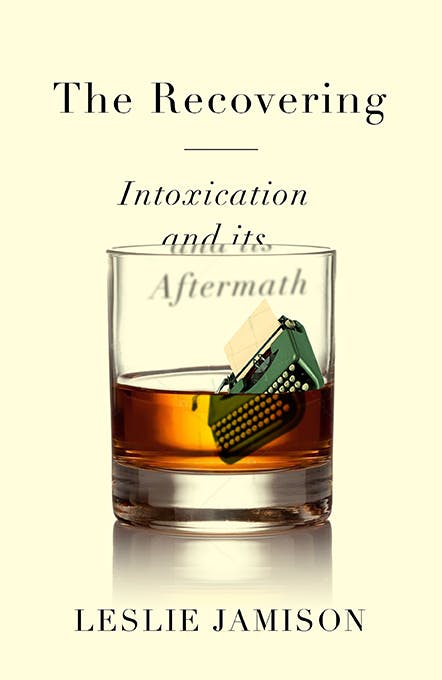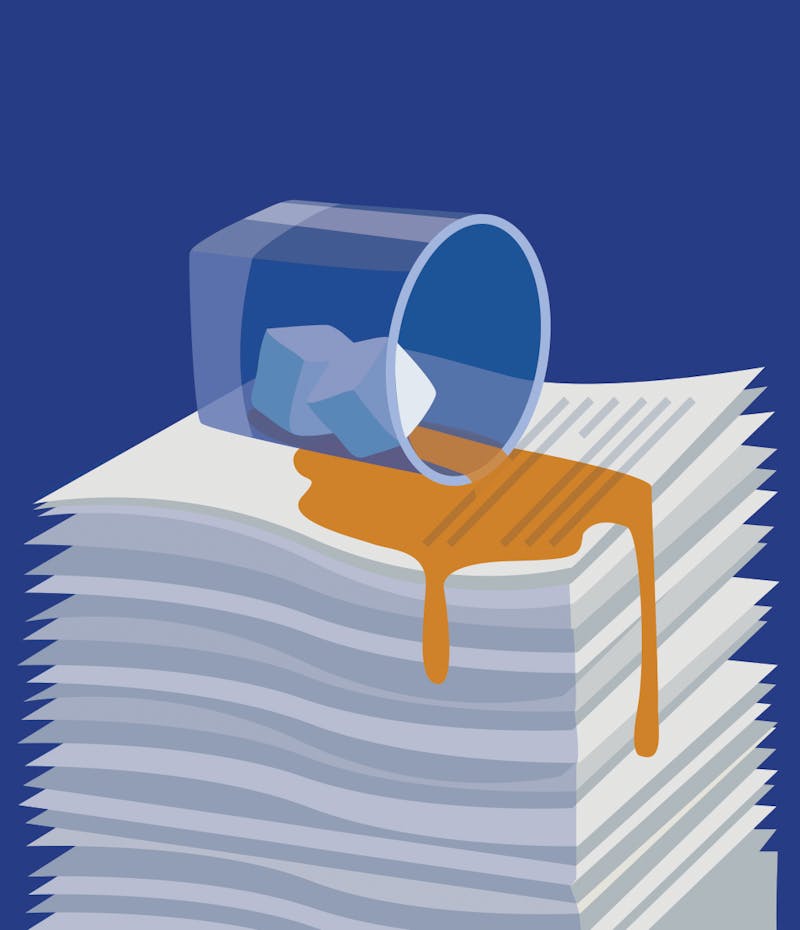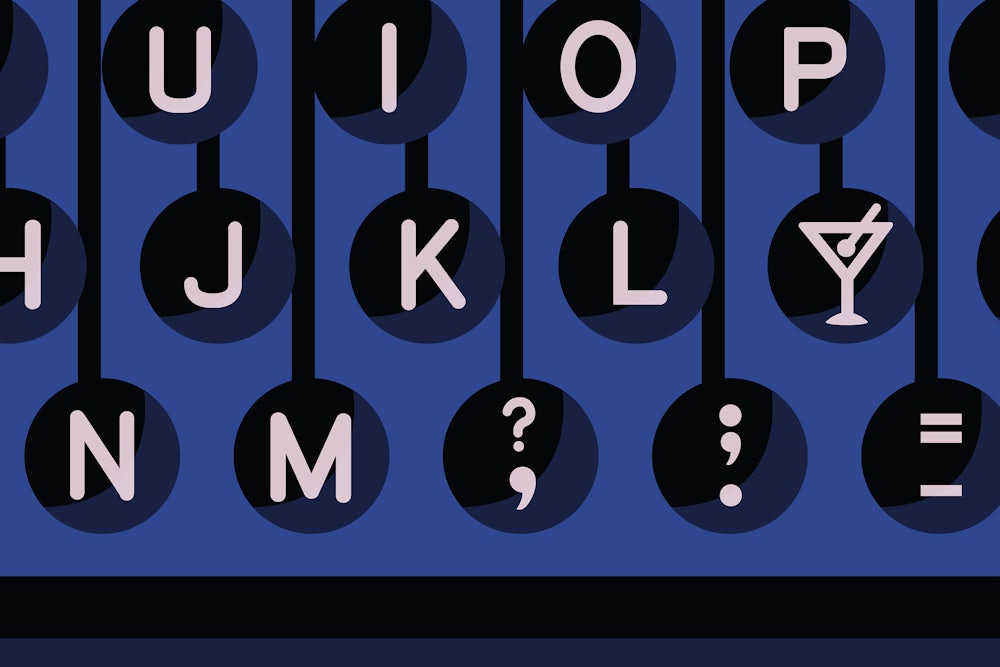By all rights, Leslie Jamison’s new memoir, The Recovering: Intoxication and its Aftermath shouldn’t work. For one thing, it rehashes a much-told story—that of addiction and its allure—and the book goes on for longer than is ideal, especially about the author’s on-again, off-again relationship with a boyfriend. There are places that should be clear that are fuzzy—indeed, parts of the book seem willfully vague, especially those about Jamison’s privileged background and stellar academic trajectory—and other places where too many details are piled on. One could argue that the narrative scoots around without a clear thread pulling it together and that the biographical particulars of well-known drunks (Jean Rhys, Malcolm Lowry, John Berryman, and Raymond Carver) are disclosed as though for the first time.
And yet The Recovering bursts with insight on how we scramble together our identities, told in a voice that manages by some literary legerdemain to be both winsomely idiosyncratic and resoundingly collective. Jamison, who is the author of a novel, The Gin Closet, and a lauded collection of essays, The Empathy Exams, is preternaturally canny about the so-called “confessional” genre she has chosen to write in, sidestepping most of its potential pitfalls—such as an atmosphere of claustrophobic solipsism—while retaining its aspects of immediacy and beguilingly unhip self-revelation. “Truth be told, I wasn’t sure exactly how to do coke,” she confides. “I knew you snorted it, but I didn’t know what that looked like.”
She pre-empts the reader’s protests:
When I told people I was writing a book about addiction and recovery, I often saw their eyes glaze. Oh, that book,they seemed to say, I’ve already read that book.... I wanted to tell them I was trying to write a book about the ways addiction is a hard story to tell, because addiction is always a story that has already been told, because it inevitably repeats itself, because it grinds down—ultimately, for everyone—to the same demolished and reductive and recycled core: Desire. Use. Repeat.
Jamison recognizes, with absolute clarity, the rut she may be getting herself into but also knows how to mostly avoid it. She resists the ideals of originality and singularity that accompany addiction stories and decides to aim instead for a voice she characterizes as “the first-person plural,” pointing out that this sort of story, especially if it includes recovery, never takes place in isolation. She wants, she tells us, to “write a book that might work like a meeting ... a book that was honest about the grit and bliss and tedium of learning to live in this way—in chorus, without the numbing privacy of getting drunk.”
Jamison relates her life in fits and starts, zig-zagging from her time at the Iowa Writers’ Workshop to her freshman year at Harvard to her graduate study at Yale. The lack of chronology makes for a degree of confusion—when, exactly, did she go to Nicaragua for a month or spend the summer in Bolivia, and how soon after breaking up with Daniel did she meet Dave?—but it allows her to digress to her heart’s content, providing in the process unexpected perceptions and expertly distilled research. She reflects on the sinister promise of late capitalism (“transformation through consumption”); the genetic factors of alcoholism; the fate of Charles Jackson after he wrote The Lost Weekend; Amy Winehouse; David Foster Wallace’s Infinite Jest; and what actually happens in Alcoholics Anonymous meetings.

In many ways, The Recovering is both a history of writers and alcoholism and an argument with the “romance of the white logic”: the idea that alcoholism, and the torment it presumably assuages, is “generative,” that it fuels creative genius. “I idolized the iconic drunk writers,” Jamison explains, “because I understood their drinking as proof of extreme interior weather: volatile and authentic. If you needed to drink that much, you had to hurt, and drinking and writing were two different responses to that same molten pain. You could numb it, or else grant it a voice.”
Jamison’s own descent into blackout-level drinking begins in college, where she feels lonely and ill at ease. “It seemed like everyone had met her boyfriend on a pre-orientation camping trip. When I looked in the mirror, I saw someone tall and ungainly, with a large nose and pleading eyes, a frizzy triangle of thick brown hair.” She has hinted earlier at the vulnerability—her chronic childhood shyness and self-harm during high school—that draws her to alcohol. Her parents are models of achievement; her mother wrote her doctoral dissertation on infant malnutrition in rural Brazil, and her father is an economist who works on health policy in the developing world. She has two much-admired older brothers, whom she loves “wildly, extravagantly.” When she is nine, her father tells Jamison somewhat opaquely that drinking “wasn’t dangerous for everyone, but it was dangerous for us.” She craves her father’s approval “like I craved perfect grades, perfect test scores.” Her parents get divorced when she is eleven.
During her first semester at Harvard, Jamison feels shrouded in sadness and develops an eating disorder; she loses 25 pounds and throws out a jar of peanut butter, afraid she might “eat the whole thing in one sitting” but then, struck by hunger, forages in a dumpster to retrieve it. Most of all, Jamison starts drinking, getting quickly caught up in alcohol’s “buzz and glint.” She describes its hold on her, a good girl looking to get out of her self-imposed confinement: “Drinking felt like the opposite of restriction. It was freedom. It was giving in to wanting, rather than refusing it. It was abandon. Abandon as in recklessness, but also sudden departure: leaving behind the starving self, its cold skeletal shell.” She functions all the while at an impressively high level, applying to and getting accepted by The Advocate, Harvard’s coveted and fiercely competitive literary magazine, and performing well in class, even while inebriated.
When Jamison moves to New Haven to begin graduate school, her addiction to alcohol deepens. “I decided to drink differently: no more beer, no more rum. Only clear liquor, which seemed purer when I imagined it traveling through me, and white wine.” She falls in love with Peter, another graduate student, and in between discussing “Victorian illness memoirs” or “the etymology of the word ‘render,’ ” they sink into the numbing experience of drinking together: “Booze let me live inside moments without the endless chatter of my own self-conscious annotation…. Self-awareness burned off like fog and there we were, watching America’s Next Top Model on his Ikea bed.” She eventually breaks up with Peter and takes up with “a charming, gregarious poet” named Dave, whose drinking style is “elegant and restrained.”
Over this period of hard drinking, Jamison sells a novel, discusses Milton’s Paradise Lost in bed after sex with Dave, has an abortion, and then undergoes heart surgery “to correct persistent tachycardia—episodes of rapid, gratuitous heartbeats that I was told would slowly wear out my heart before its time.” Her doctor advises her to lay off drinking for a few months, advice Jamison doesn’t follow. She decides intermittently to stop drinking—once right before she takes her oral exams, which require her to “sit in a room full of professors firing questions at me about Shakespeare and American modernism and Chaucer’s ‘Parliament of Fowls.’ It made me sad to think of passing the exams sober,” she poignantly adds, “because I had no idea how I’d celebrate.”

The Recovering, as its present participle title suggests, is a story of the long, painful, resistant, and unoriginal road to getting—and staying—sober as much as it is a narrative of addiction. But it also conveys the “sinuous, glimmering energy of recovery” as Jamison attends AA meetings, reading the Big Book “with another woman over night-discounted muffins” even as she secretly concocts a plan to keep drinking. These meetings, which require that she give up her self-loathing (“the flip side of narcissism”) and her belief in her own uniqueness (“What was identity if it wasn’t fundamentally a question of difference? What defined a voice if not distinction?”), bring us other characters, some much more downbeat and desperate than Jamison.
Although several reviewers have complained that this part of the book lags, I found the disparate sobriety stories of Sawyer, Gwen, Marcus, and Shirley essential to Jamison’s book, serving to widen its scope: Along the way, it mutates from one gifted and successful young woman’s tale—the story of a woman who believed all her life “that I had to earn affection and love by being interesting, and so I had frantically tried to become really fucking interesting”—into a larger inquiry into how we seek to heal ourselves. Although the why of her own addiction is given oddly short shrift (“My childhood was easier than most and I ended up drinking anyway”), Jamison is acutely aware of the lack, the hunger that addiction addresses, both for more ordinary folk and for creative types who harbor the fantasy “that brilliant writing might redeem a flawed life.” Like other addicts, she falls off the wagon only to try again: “Part of proving that you’re truly ready to recover—in drug court, in a meeting, in a memoir—involves admitting that you don’t know if you can recover at all. Part of getting into the right narrative involves admitting you can’t see the end of it.”
The Recovering creates its own grainy context, defying all the usual tropes of addiction memoirs. Part confession, part literary criticism, part cultural analysis, part musing, and part hard-edged reporting (Jamison visits an early recovery program called the Narcotic Farm and the region, the Olympic Peninsula, where Raymond Carver spent his postalcoholic life), Jamison has written an extraordinary document of self-reckoning that will make you think and rethink the trajectory of your own life in its “mundane realities” as well as its “cinematic epic mode.” This is a book about one of us, all of us, and the yearnings that take us to dark as well as light-filled places.
